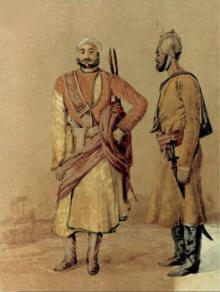Government of the Mughal Empire
  Flag and Seal of the Mughal Empire | |
| Overview | |
| Established | 21 April 1526 |
| Dissolved | 21 September 1857 |
| State | Mughal Empire |
| Leader | Mughal emperor |
| Ministries | Vakil / Grand vizier Ministry of finance Ministry of the military Ministry of law/religious patronage Ministry of the imperial household and public works |
| Headquarters | Agra Delhi Lahore Fatehpur Sikri |
The government of the Mughal Empire was a highly centralised bureaucracy, most of which was instituted during the rule of the third Mughal emperor, Akbar.[1][2] The central government was headed by the Mughal emperor; immediately beneath him were four ministries. The finance/revenue ministry was responsible for controlling revenues from the empire's territories, calculating tax revenues, and using this information to distribute assignments. The ministry of the military (army/intelligence) was headed by an official titled mir bakhshi, who was in charge of military organisation, messenger service, and the mansabdari system. The ministry in charge of law/religious patronage was the responsibility of the sadr as-sudr, who appointed judges and managed charities and stipends. Another ministry was dedicated to the imperial household and public works.[1][3]
Administrative division
[edit]The territory of the empire was divided into provincial level administrative units known as Subahs (provinces), each was controlled by official governor called subahdar.[4] Subahs were subdivided into administrative units known as Sarkars, which further divided into smaller administrative units known as Pargana. The government at the Pargana level consisted of a Muslim judge (Qadi) and a local tax collector official.[1][3] Each Pargana has contained more smaller administrative units which called Tarafs, which in their turn consisted of several villages plus some uninhabited mountain and forest land.[5]
Mughal administrative divisions were not static, as these territories were often changed and reconstituted to suit the evolving physical territories, and to facillitate the better administration of the land cultivation. For example, a sarkar could changed its status into a subah, and Parganas often transferred into another Sarkars. However, hierarchial authority of each division could fall under multiple overlapping jurisdictions. Administrative divisions were also vague in their geographical mapping, as the Mughal state did not have enough resources or authority for detailed survey of land; hence the geographical limits obstructed the empire to formalise the mappings of their territories. The empire instead relying on recorded statistic details about each division to assess the territory's revenue, based on more simple form of land surveys.[6]
The structure of the central government of the empire resembles those Subah provincial units government; To facillitate to government control, each subah had its own bakhshi, sadr as-sudr, and finance minister that reported directly to the central government rather than the subahdar.[citation needed] The empire also established "Dastur-ul-Amal", an office responsible for the administration of land revenue. Each cultivator of the land which assigned was known as "Patta", and "Qabuliyat", a status of agreement regarding the said land's revenue.[7]
Capitals
[edit]The Mughals had multiple imperial capitals, established over the course of their rule. These were the cities of Agra, Delhi, Lahore, and Fatehpur Sikri. Power often shifted back and forth between these capitals.[8] Sometimes this move was due to necessary political and military demands, while also due to ideological reasons; such as Akbar's establishment of new capital in Fatehpur Sikri; Another reason was because the marginal cost of establishing a new imperial capital.[9] There were occasions where two imperial capitals existed simultaneously, in Mughal history. Certain cities also served as temporary provincial capitals, such as when Aurangzeb shifting his central government to Aurangabad in the Deccan.[8]
The imperial camp are used for military expeditions and royal entourage which also served as a kind of mobile, "de facto" administrative capital. From the time of Akbar, Mughal camps were huge in scale, accompanied by numerous personages associated with the royal court, as well as soldiers and labourers. All administration and governance was carried out within them. The Mughal Emperors spent a significant portion of their ruling period within these camps.[10]
After Aurangzeb, the Mughal capital definitively became the walled city of Shahjahanabad (modern day Old Delhi).[11][12]
Law
[edit]
The Mughal Empire's legal system was context-specific and evolved over the course of the empire's rule. Being a Muslim state, the empire employed fiqh (Islamic jurisprudence) and therefore the fundamental institutions of Islamic law such as those of the qadi (judge), mufti (jurisconsult), and muhtasib (censor and market supervisor) were well-established in the Mughal Empire. However, the dispensation of justice also depended on other factors, such as administrative rules, local customs, and political convenience. This was due to Persianate influences on Mughal ideology, and the fact that the Mughal Empire governed a non-Muslim majority.[13]
Legal ideology
[edit]The Mughal Empire followed the Sunni Hanafi system of jurisprudence. In its early years, the empire relied on Hanafi legal references inherited from its predecessor, the Delhi Sultanate. These included the al-Hidaya (the best guidance) and the Fatawa al-Tatarkhaniyya (religious decisions of the Emire Tatarkhan). During the Mughal Empire's peak, the Al-Fatawa al-'Alamgiriyya was commissioned by Emperor Aurangzeb. This compendium of Hanafi law sought to serve as a central reference for the Mughal state that dealt with the specifics of the South Asian context.[14]
The Mughal Empire also drew on Persianate notions of kingship. Particularly, this meant that the Mughal emperor was considered the supreme authority on legal affairs.[13]
Courts of law
[edit]Various kinds of courts existed in the Mughal empire. One such court was that of the qadi. The Mughal qadi was responsible for dispensing justice; this included settling disputes, judging people for crimes, and dealing with inheritances and orphans. The qadi also had additional importance with regards to documents, as the seal of the qadi was required to validate deeds and tax records. Qadis did not constitute a single position, but made up a hierarchy. For example, the most basic kind was the pargana (district) qadi. More prestigious positions were those of the qadi al-quddat (judge of judges) who accompanied the mobile imperial camp, and the qadi-yi lashkar (judge of the army).[13] Qadis were usually appointed by the emperor or the sadr-us-sudr (chief of charities).[13][15] The jurisdiction of the qadi was availed by Muslims and non-Muslims alike.[16]
The jagirdar (local tax collector) was another kind of official approached, especially for high-stakes cases. Subjects of the Mughal Empire also took their grievances to the courts of superior officials who held more authority and punitive power than the local qadi. Such officials included the kotwal (local police), the faujdar (an officer controlling multiple districts and troops of soldiers), and the most powerful, the subahdar (provincial governor). In some cases, the emperor themself dispensed justice directly.[13] Jahangir was known to have installed a "chain of justice" in the Agra fort that any aggrieved subject could shake to get the attention of the emperor and bypass the inefficacy of officials.[17]
Self-regulating tribunals operating at the community or village level were common, but sparse documentation of them exists. For example, it is unclear how panchayats (village councils) operated in the Mughal era.[13]
List of Mughal Emperors
[edit]See also
[edit]- Mughal dynasty
- Mughal emperors
- Economy of the Mughal Empire
- Foreign relations of the Mughal Empire
- Islam in South Asia
Further reading
[edit]References
[edit]- ^ a b c Robinson, Francis (2009), "Mughal Empire", The Oxford Encyclopedia of the Islamic World, Oxford University Press, doi:10.1093/acref/9780195305135.001.0001, ISBN 978-0-19-530513-5, retrieved 28 March 2022
- ^ Burton-Page, J.; Islam, Riazul; Athar Ali, M.; Moosvi, Shireen; Moreland, W. H.; Bosworth, C. E.; Schimmel, Annemarie; Koch, Ebba; Hall, Margaret (24 April 2012), "Mug̲h̲als", Encyclopaedia of Islam, Second Edition, Brill, doi:10.1163/1573-3912_islam_com_0778, retrieved 31 March 2022
- ^ a b Conermann, Stephan (4 August 2015), "Mughal Empire", Encyclopedia of Early Modern History Online, Brill, doi:10.1163/2352-0272_emho_com_024206, retrieved 28 March 2022
- ^ y George Clifford Whitworth (2016). An Anglo-indian Dictionary: A Glossary Of Indian Terms Used In English, And Of Such English Or Other Non-indian Terms As Have Obtained Special Meanings In India. Palala Press. p. 301. ISBN 978-1354764114.
- ^ Ramsay Muir (2006). The Making Of British India - 1756-1858. Read Books. p. 289. ASIN 1406723789.
- ^ Michael, Bernardo A. (2012). Statemaking and Territory in South Asia. Anthem Press. p. 69, 75, 77-78. doi:10.7135/upo9780857285324.005. ISBN 978-0-85728-532-4.
- ^ I.A. Khan (2022). Medieval History (Emergence of Islam to downfall of mughal empire). Blue Rose Publishers. Retrieved 26 July 2024.
- ^ a b Sinopoli, Carla M. (1994). "Monumentality and Mobility in Mughal Capitals". Asian Perspectives. 33 (2): 294–295. ISSN 0066-8435. JSTOR 42928323.
- ^ Sinopoli, Carla M. (1994). "Monumentality and Mobility in Mughal Capitals". Asian Perspectives. 33 (2): 304–305. ISSN 0066-8435. JSTOR 42928323.
- ^ Sinopoli, Carla M. (1994). "Monumentality and Mobility in Mughal Capitals". Asian Perspectives. 33 (2): 296 & 298. ISSN 0066-8435. JSTOR 42928323.
- ^ Edmund., Bosworth, Clifford (2008). Historic cities of the Islamic world. Brill. p. 127. ISBN 978-90-04-15388-2. OCLC 231801473.
{{cite book}}: CS1 maint: multiple names: authors list (link) - ^ Catherine B. Asher (1992). "7". Architecture of Mughal India, Volume 4. Cambridge University Press. p. 292. ISBN 0521267285. Retrieved 27 July 2024.
- ^ a b c d e f Chatterjee, Nandini (1 December 2019), "Courts of law, Mughal", Encyclopaedia of Islam, THREE, Brill, doi:10.1163/1573-3912_ei3_com_25171, retrieved 13 December 2021
- ^ Khalfaoui, Mouez. "Mughal Empire and Law". Oxford Islamic Studies Online. Archived from the original on 13 December 2021.
- ^ Conermann, Stephan (4 August 2015), "Mughal Empire", Encyclopedia of Early Modern History Online, Brill, doi:10.1163/2352-0272_emho_com_024206, retrieved 25 March 2022
- ^ Chatterjee, Nandini (2014). "Reflections on Religious Difference and Permissive Inclusion in Mughal Law". Journal of Law and Religion. 29 (3): 396–415. doi:10.1017/jlr.2014.20. hdl:10871/15975. ISSN 0748-0814. S2CID 143513602.
- ^ Eaton, Richard M. (2019). India in the Persianate Age : 1000-1765. University of California Press. p. 272. ISBN 978-0-520-97423-4. OCLC 1243310832.
